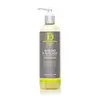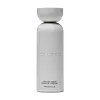What's inside
What's inside
 Key Ingredients
Key Ingredients

 Benefits
Benefits

 Concerns
Concerns

 Ingredients Side-by-side
Ingredients Side-by-side

Water
Skin ConditioningSodium C14-16 Olefin Sulfonate
CleansingCocamidopropyl Hydroxysultaine
CleansingPolyquaternium-7
Cocamide Mea
EmulsifyingAcrylamidopropyltrimonium Chloride/Acrylamide Copolymer
Phenoxyethanol
PreservativeBenzoic Acid
MaskingEthylhexylglycerin
Skin ConditioningGlycereth-2 Cocoate
EmulsifyingPropanediol
SolventGlycol Distearate
EmollientPrunus Amygdalus Dulcis Fruit Water
Skin ConditioningPersea Gratissima Fruit Extract
EmollientButyrospermum Parkii Leaf Extract
EmollientOlea Europaea Fruit Extract
BleachingSimmondsia Chinensis Seed Extract
AbrasiveTheobroma Cacao Extract
Skin ConditioningCocos Nucifera Fruit Extract
EmollientAleurites Moluccanus Seed Extract
Skin ConditioningParfum
MaskingBenzyl Benzoate
AntimicrobialCitral
PerfumingGeraniol
PerfumingLinalool
PerfumingLimonene
PerfumingWater, Sodium C14-16 Olefin Sulfonate, Cocamidopropyl Hydroxysultaine, Polyquaternium-7, Cocamide Mea, Acrylamidopropyltrimonium Chloride/Acrylamide Copolymer, Phenoxyethanol, Benzoic Acid, Ethylhexylglycerin, Glycereth-2 Cocoate, Propanediol, Glycol Distearate, Prunus Amygdalus Dulcis Fruit Water, Persea Gratissima Fruit Extract, Butyrospermum Parkii Leaf Extract, Olea Europaea Fruit Extract, Simmondsia Chinensis Seed Extract, Theobroma Cacao Extract, Cocos Nucifera Fruit Extract, Aleurites Moluccanus Seed Extract, Parfum, Benzyl Benzoate, Citral, Geraniol, Linalool, Limonene
Water
Skin ConditioningSodium Lauroyl Methyl Isethionate
CleansingGlycerin
HumectantCocamidopropyl Betaine
CleansingPolyquaternium-7
Polyquaternium-10
Glycol Distearate
EmollientHydrolyzed Rice Protein
Skin ConditioningLactobacillus
Skin ConditioningOlea Europaea Fruit Oil
MaskingMoringa Oleifera Seed Oil
EmollientAdansonia Digitata Seed Oil
EmollientNigella Sativa Seed Oil
EmollientArgania Spinosa Kernel Oil
EmollientRosmarinus Officinalis Leaf Oil
MaskingSodium Hyaluronate
HumectantHyssopus Officinalis Extract
MaskingCoco-Glucoside
CleansingGlyceryl Oleate
EmollientGuar Hydroxypropyltrimonium Chloride
Skin ConditioningHydrolyzed Hyaluronic Acid
HumectantEclipta Prostrata Extract
Skin ConditioningHibiscus Rosa-Sinensis Flower Extract
HumectantChlorella Ferment
Skin ConditioningTremella Fuciformis Polysaccharide
Emulsion StabilisingCaramel
Cosmetic ColorantSodium Phytate
1,2-Hexanediol
Skin ConditioningHydroxyethylcellulose
Emulsion StabilisingParfum
MaskingEthylhexylglycerin
Skin ConditioningPhenoxyethanol
PreservativeTrisodium Ethylenediamine Disuccinate
Sodium Benzoate
MaskingSodium Phosphate
BufferingCitric Acid
BufferingTocopherol
AntioxidantHydrogenated Palm Glycerides Citrate
EmollientDisodium Phosphate
BufferingPolysorbate 60
EmulsifyingBenzyl Alcohol
PerfumingPotassium Sorbate
PreservativeLactic Acid
BufferingLinalool
PerfumingWater, Sodium Lauroyl Methyl Isethionate, Glycerin, Cocamidopropyl Betaine, Polyquaternium-7, Polyquaternium-10, Glycol Distearate, Hydrolyzed Rice Protein, Lactobacillus, Olea Europaea Fruit Oil, Moringa Oleifera Seed Oil, Adansonia Digitata Seed Oil, Nigella Sativa Seed Oil, Argania Spinosa Kernel Oil, Rosmarinus Officinalis Leaf Oil, Sodium Hyaluronate, Hyssopus Officinalis Extract, Coco-Glucoside, Glyceryl Oleate, Guar Hydroxypropyltrimonium Chloride, Hydrolyzed Hyaluronic Acid, Eclipta Prostrata Extract, Hibiscus Rosa-Sinensis Flower Extract, Chlorella Ferment, Tremella Fuciformis Polysaccharide, Caramel, Sodium Phytate, 1,2-Hexanediol, Hydroxyethylcellulose, Parfum, Ethylhexylglycerin, Phenoxyethanol, Trisodium Ethylenediamine Disuccinate, Sodium Benzoate, Sodium Phosphate, Citric Acid, Tocopherol, Hydrogenated Palm Glycerides Citrate, Disodium Phosphate, Polysorbate 60, Benzyl Alcohol, Potassium Sorbate, Lactic Acid, Linalool
Ingredients Explained
These ingredients are found in both products.
Ingredients higher up in an ingredient list are typically present in a larger amount.
Ethylhexylglycerin (we can't pronounce this either) is commonly used as a preservative and skin softener. It is derived from glyceryl.
You might see Ethylhexylglycerin often paired with other preservatives such as phenoxyethanol. Ethylhexylglycerin has been found to increase the effectiveness of these other preservatives.
Glycol Distearate serves as a pearlizing or opacifying agent in cosmetic products.
It's often included in cleansers and haircare products to give them a lustrous or shimmering appearance.
It is derived from stearic acid, a natural fatty acid commonly found in vegetable oils and animal fats.
Glycol Distearate isn't fungal acne safe.
Learn more about Glycol DistearateLinalool is a fragrance and helps add scent to products. It's derived from common plants such as cinnamon, mint, citrus, and lavender.
Like Limonene, this ingredient oxidizes when exposed to air. Oxidized linalool can cause allergies and skin sensitivity.
This ingredient has a scent that is floral, spicy tropical, and citrus-like.
Learn more about LinaloolParfum is a catch-all term for an ingredient or more that is used to give a scent to products.
Also called "fragrance", this ingredient can be a blend of hundreds of chemicals or plant oils. This means every product with "fragrance" or "parfum" in the ingredients list is a different mixture.
For instance, Habanolide is a proprietary trade name for a specific aroma chemical. When used as a fragrance ingredient in cosmetics, most aroma chemicals fall under the broad labeling category of “FRAGRANCE” or “PARFUM” according to EU and US regulations.
The term 'parfum' or 'fragrance' is not regulated in many countries. In many cases, it is up to the brand to define this term.
For instance, many brands choose to label themselves as "fragrance-free" because they are not using synthetic fragrances. However, their products may still contain ingredients such as essential oils that are considered a fragrance by INCI standards.
One example is Calendula flower extract. Calendula is an essential oil that still imparts a scent or 'fragrance'.
Depending on the blend, the ingredients in the mixture can cause allergies and sensitivities on the skin. Some ingredients that are known EU allergens include linalool and citronellol.
Parfum can also be used to mask or cover an unpleasant scent.
The bottom line is: not all fragrances/parfum/ingredients are created equally. If you are worried about fragrances, we recommend taking a closer look at an ingredient. And of course, we always recommend speaking with a professional.
Learn more about ParfumPhenoxyethanol is a preservative that has germicide, antimicrobial, and aromatic properties. Studies show that phenoxyethanol can prevent microbial growth. By itself, it has a scent that is similar to that of a rose.
It's often used in formulations along with Caprylyl Glycol to preserve the shelf life of products.
Polyquaternium-7 is a light to clear colored liquid. It is commonly found in haircare products for its film-forming and anti-static properties.
According to a manufacturer, it is a non-paraben and specially developed for negatively charged surfactant systems. This makes it a great hairstyle holder and helps to improve wet hair detangling without adding buildup.
Water. It's the most common cosmetic ingredient of all. You'll usually see it at the top of ingredient lists, meaning that it makes up the largest part of the product.
So why is it so popular? Water most often acts as a solvent - this means that it helps dissolve other ingredients into the formulation.
You'll also recognize water as that liquid we all need to stay alive. If you see this, drink a glass of water. Stay hydrated!
Learn more about Water